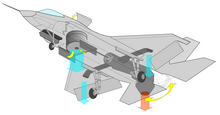
F-35B's thrust vectoring nozzle and lift fan
The engine used on the F-35 is the Pratt & Whitney F135. An alternative engine, the General Electric/Rolls-Royce F136, was under development until December 2011 when the manufacturers canceled the project. Neither the F135 or F136 engines are designed to supercruise in the F-35,however the F-35 can achieve a limited supercruise of Mach 1.2 for 150 miles. The F135 is the second (radar) stealthy afterburning jet engine and, like the Pratt & Whitney F119 from which it was derived, has suffered from pressure pulsations in the afterburner at low altitude and high speed or "screech" during development. Turbine bearing health will be monitored with thermoelectric-powered sensors.
The F-35 has a maximum speed of over Mach 1.6. With a maximum takeoff weight of 60,000 lb (27,000 kg), the Lightning II is considerably heavier than the lightweight fighters it replaces. In empty and maximum gross weights, it more closely resembles the single-seat, single-engine Republic F-105 Thunderchief, which was the largest single-engine fighter of the Vietnam war era. The F-35's modern engine delivers over 60 percent more thrust in an aircraft of the same weight so that in thrust to weight and wing loading it is much closer to a comparably equipped F-16.
The STOVL F-35B is outfitted with the Rolls-Royce LiftSystem, designed by Lockheed Martin and developed by Rolls-Royce. This system more resembles the Russian Yak-141 and German VJ 101D/E than the preceding STOVL Harrier Jump Jet and the Rolls-Royce Pegasus engine. The Lift System is composed of a lift fan, drive shaft, two roll posts and a "Three Bearing Swivel Module" (3BSM). The 3BSM is a thrust vectoring nozzle which allows the main engine exhaust to be deflected downward at the tail of the aircraft. The lift fan is near the front of the aircraft and provides a counterbalancing thrust using two counter-rotating blisks.It is powered by the engine's low-pressure (LP) turbine via a drive shaft and gearbox. Roll control during slow flight is achieved by diverting unheated engine bypass air through wing-mounted thrust nozzles called Roll Posts.
F136 funding came at the expense of other parts of the program, impacting on unit costs. The F136 team has claimed that their engine has a greater temperature margin which may prove critical for VTOL operations in hot, high altitude conditions.Pratt & Whitney has tested higher thrust versions of the F135, partly in response to GE's claims that the F136 is capable of producing more thrust than the 43,000 lbf (190 kN) of early F135s. The F135 has demonstrated a maximum thrust of over 50,000 lbf (220 kN) during testing;making it the most powerful engine ever installed in a fighter aircraft as of 2010.
The F-35 has a maximum speed of over Mach 1.6. With a maximum takeoff weight of 60,000 lb (27,000 kg), the Lightning II is considerably heavier than the lightweight fighters it replaces. In empty and maximum gross weights, it more closely resembles the single-seat, single-engine Republic F-105 Thunderchief, which was the largest single-engine fighter of the Vietnam war era. The F-35's modern engine delivers over 60 percent more thrust in an aircraft of the same weight so that in thrust to weight and wing loading it is much closer to a comparably equipped F-16.
The STOVL F-35B is outfitted with the Rolls-Royce LiftSystem, designed by Lockheed Martin and developed by Rolls-Royce. This system more resembles the Russian Yak-141 and German VJ 101D/E than the preceding STOVL Harrier Jump Jet and the Rolls-Royce Pegasus engine. The Lift System is composed of a lift fan, drive shaft, two roll posts and a "Three Bearing Swivel Module" (3BSM). The 3BSM is a thrust vectoring nozzle which allows the main engine exhaust to be deflected downward at the tail of the aircraft. The lift fan is near the front of the aircraft and provides a counterbalancing thrust using two counter-rotating blisks.It is powered by the engine's low-pressure (LP) turbine via a drive shaft and gearbox. Roll control during slow flight is achieved by diverting unheated engine bypass air through wing-mounted thrust nozzles called Roll Posts.
F136 funding came at the expense of other parts of the program, impacting on unit costs. The F136 team has claimed that their engine has a greater temperature margin which may prove critical for VTOL operations in hot, high altitude conditions.Pratt & Whitney has tested higher thrust versions of the F135, partly in response to GE's claims that the F136 is capable of producing more thrust than the 43,000 lbf (190 kN) of early F135s. The F135 has demonstrated a maximum thrust of over 50,000 lbf (220 kN) during testing;making it the most powerful engine ever installed in a fighter aircraft as of 2010.
No comments:
Post a Comment